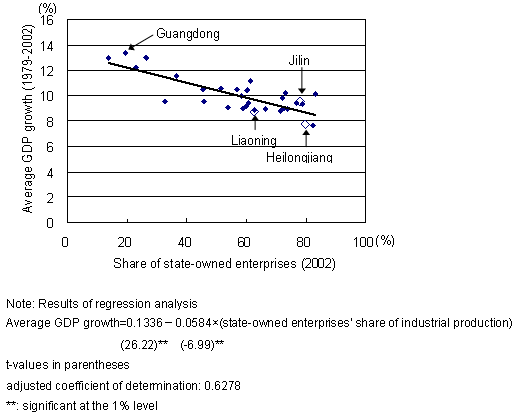In discussions on the regional development gap in China, there is now increasing attention being focused not only on the "east-west gap" between the coastal and inland regions, but also the "north-south gap." Since the introduction of market-opening policies, unlike the southern province of Guangdong which has made tremendous progress by using foreign investment as a lever, the traditional industrial belt straddling the three northeastern provinces (Liaoning, Jilin and Heilongjiang) has fallen behind in terms of economic development because of outdated equipment and the fact that many state-owned enterprises with excess labor are struggling. Reflecting this, the three northeastern provinces, which in 1978 made up 16.5% of the nation's entire industrial output had dropped by almost one-half to 8.6% by 2002. In order to revitalize this "old industrial base," the "northeast development" strategy was adopted at the 16th National Congress of the Communist Party in November 2002. This strategy has come to draw more attention since Premier Wen Jiabao said that, "The development of the northeast region and the western development strategy are the two wheels of the east and west," during his visit to Liaoning Province in June 2003.
The three northeastern provinces had won renown as China's heavy industry base during the planned economy era. Since the birth of the People's Republic of China in 1949, these three provinces were the frontrunners of the Chinese economy, thanks to the geographical advantages of having both the industrial infrastructure inherited from the days of the Japanese occupation and support from the Soviet Union. Liaoning's steelworks (Anshan Steel Co.), Jilin's automobiles (Changchun's First Automotive Works) and Heilongjiang's energy industry (Daqing's oil) are famous. The region was also strong in the area of agriculture, and was China's grain belt. However, since the 1980s, the shift to a market economy and the opening of China's markets have exposed the fact that these industries were not in line with the nation's comparative advantages, and many firms have become unable to withstand the intensifying competition and their operations are on a downward slide. Furthermore, some firms and areas are beginning to witness the exhaustion of mineral resources upon which they have been heavily dependent. Agriculture has also lost the edge it once enjoyed during the days of a closed economy, especially after the reduction of import tariffs that followed China's entry into the World Trade Organization. Thus, there is an increasing need to build a new industrial structure in line with the region's comparative advantages.
Furthermore, the high percentage of state-owned enterprises - the pillar of the Chinese economy in the days of a planned economy - in the three northeast provinces is now also a factor that is putting a drag on economic development amid the new environment of a market-oriented economy. The low efficiency of state-owned enterprises is a universal phenomenon, and China is no exception. In fact, since market-opening policies were introduced, regions with a higher share of state-owned enterprises have been seeing lower growth (and regions with a higher percentage of non-state-owned enterprises have experienced higher growth) ( diagram ). A closer examination of the relationship between economic growth in China's regions (the average between 1979 and 2002) and the share of state-owned enterprises (as of 2002), based on the statistical method of regression, shows that for every percentage point rise in the share of state-owned enterprises, average annual economic growth falls by 0.0584%. Because the share of state-owned enterprises is higher in the three northeastern provinces than in other regions, their economic growth is lower than the national average. For example, state-owned firms make up about 80% of the industrial output of Heilongjiang Province, about 60 percentage points more than the 20% or so of industrial output that state-owned firms contribute to in Guangdong Province. According to the above estimate, 3.5% (=0.0584 x 60%) of the 5.7% difference in average annual economic growth can be explained by the difference in the share of state-owned enterprises in the two provinces.
From the above, we can see that the key to developing the northeast provinces is to reduce the share of state-owned enterprises while at the same time increasing that of non-state-owned firms. The former can be achieved directly through privatization, while the latter can be attained by the fostering of private firms and introduction of foreign capital. Fortunately, such an environment is already in place with the waning of socialist ideologies and WTO membership. In fact, Chinese authorities have made it clear that they will "uphold the idea of reform and market-opening, and follow market principles" when working to develop the northeast provinces. The inflow of foreign capital is especially welcome, not only in the form of new investment, but also as infusions of capital into state-owned enterprises in the form of mergers and acquisitions (M&A). The aim of this is to not only receive foreign capital but also introduce advanced technology and management know-how. Japan is geographically close to northeastern China and its historical ties with the region also run deep, and for this reason, there are great expectations that Japan will play a vital role in its development.



